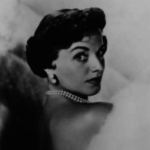
About
Born: 1922
Died: 2016
Born Katherine La Verne Starks on a reservation in Oklahoma, Kay Starr was raised in Texas and Tennessee and absorbed many of the musical styles popular in the American South and Southwest. She typically identified herself as Native American (Choctaw, Cherokee, and Iroquois)—along with what one newspaper described as “a small but potent flow of Irish.” According to a syndicated article about her published in 1964, the family lived on about $8 a week during the Depression.
Starr was a precocious young musician, regularly heard live on the radio in Dallas, Fort Worth, and later in Memphis. Initially, she billed herself as a “hillbilly” singer and performed country and western swing—genres that she would return to throughout her career. When she was fifteen, jazz violinist and bandleader Joe Venuti hired her as a “girl singer.” Starr proved to be a versatile singer, which contributed to her success. She performed and recorded with the likes of Glenn Miller and Charlie Barnet into the 1940s, worked with Les Paul, and made records with Tennessee Ernie Ford in the 1950s.
Perhaps due in part to an illness and treatment for nodules that had somewhat altered her vocal timbre by 1945, Capitol Records increasingly began marketing Starr as a “blues” singer. Articles from the early fifties describe Starr as white, but with qualifications: “Coon-Shouting Indian Singer Hits Jackpot in Jukeboxes,” proclaimed one headline in 1952. The article, an AP wire story printed in hundreds of papers, introduced Starr as a “buxom Indian lass who can’t read a note of music,” called her the “white Bessie Smith,” and labeled her style “gutbucket.” It neither the first nor the last story to imply that Starr’s heritage was the reason for her success in the blues. Another syndicated column from January 1951 praised Starr’s ability to succeed in a black genre that had “[eluded] white singers.” The reporter describes her sound as a fusion of Bessie Smith and jazz singer Mildred Bailey, the latter an enrolled member of the Coeur d’Alene tribe.
When rock and roll finally caught the attention of major record labels in 1955, Starr—then on the RCA—may have seemed perfectly positioned to capitalize on the fad, thanks to her proven ability to sell both country and blues records. Her novelty record “Rock and Roll Waltz” was a major hit in 1955, and while it also gently poked fun at rock and roll, the single started as an inside joke on Alan Freed’s program. Freed apparently promoted the record with his teen audiences as a rock and roll novelty, and available sheet music for the song bore his likeness as well as Starr’s. Starr did not initially want to record the song, and commented several times to biographers and reporters that it lacked the “blood and guts” that typically characterized her records.
Starr did not achieve lasting fame with rock and roll audiences, but she did appear on Billboard’s Hot 100 chart into the 1960s. Her catalog of recordings remained stylistically diverse, though she focused particularly on jazz. Starr continued to be an active musician for much of her long life. She died at age 94 from complications of Alzheimer’s disease.
“You’ve Got To See Your Mamma Ev’ry Night” / “Mercy, Mercy, Mercy.” Capitol F-497 (1948).
“I’ll Never Been Free” / “Ain’t Nobody’s Business But My Own.” Capitol F-1124 (1950). With “Tennessee” Ernie Ford.
“I’m The Lonesomest Gal In Town” / “Sharecroppin’ Blues.” Capitol F-854 (1950).
“On A Honky-tonk Hardwood Floor” / “Two Brothers.” Capitol F-1856 (1953).
“The Rock And Roll Waltz” / “I’ve Changed My Mind A Thousand Times.” RCA 47-6359 (1955).
Rockin’ with Kay. RCA LPM-1720 (1958).
Advertisement, Variety, 24 March 1948, 43.
“Limelight Personality,” Daily Press (Newport News, Virginia), 27 April 1952.
James Bacon, “Coon-Shouting Indian Singer Hits Jackpot In Jukeboxes,” Akron Beacon-Journal, 20 April 1952.
Bill Becker, “Kay Starr’s a Star Singing the Blues,” The Daily Tribune (Wisconsin Rapids, WI), 27 January 1951.
Alan Freed’s Rock and Roll Party (New York: Sheldon Music, 1955).
Jim Bishop, “The Kay Starr Story,” Daily Mail (Hagerstown, MD), 30 Jun 1964.
Gary Giddens and Kay Starr, “A Starr is Reborn” in Reading Jazz: A Gathering of Autobiography, Reportage, and Criticism from 1919 to Now, ed. Robert Gottlieb (New York: Vintage Books, 1999), 659-660.
David Belcher, “Kay Starr, Hillbilly Singer With Crossover Appeal, Dies at 94,” New York Times, 3 November 2016 (https://www.nytimes.com/2016/11/04/arts/music/kay-starr-hillbilly-singer-with-crossover-appeal-dies-at-94.html)
